Emerging Management Solutions
The development of innovative technologies and improvements to conventional systems offers enhanced methods for treating wastewater. Some of these new management strategies are aimed at increasing treatment efficiency, improving the quality of discharge water, or generating profit from a valuable resource recovered from wastewater.
Increasing Efficiency of Septic Systems
Widespread usage of septic systems has resulted in the development of a variety of modifications which address unique treatment needs. These additional treatment steps ensure that the wastewater that enters the environment is cleaner. Since these systems are usually paired with wells as a source of drinking water, this improves the quality of drinking water as well. Treatment needs can include increasing the capacity and efficiency of the systems or reducing nutrient loads. These system improvements are becoming more and more common, and even required in some places that are especially vulnerable to wastewater impacts.
A chamber septic system is an alternative to the traditional gravel/stone septic design, which is easier to construct, but not as effective. In a chamber system, the drainfield is made up of a series of closed chambers surrounded by soil. Wastewater moves through the septic tank and then into the chambers, where microbes in the soil help to remove pathogens.
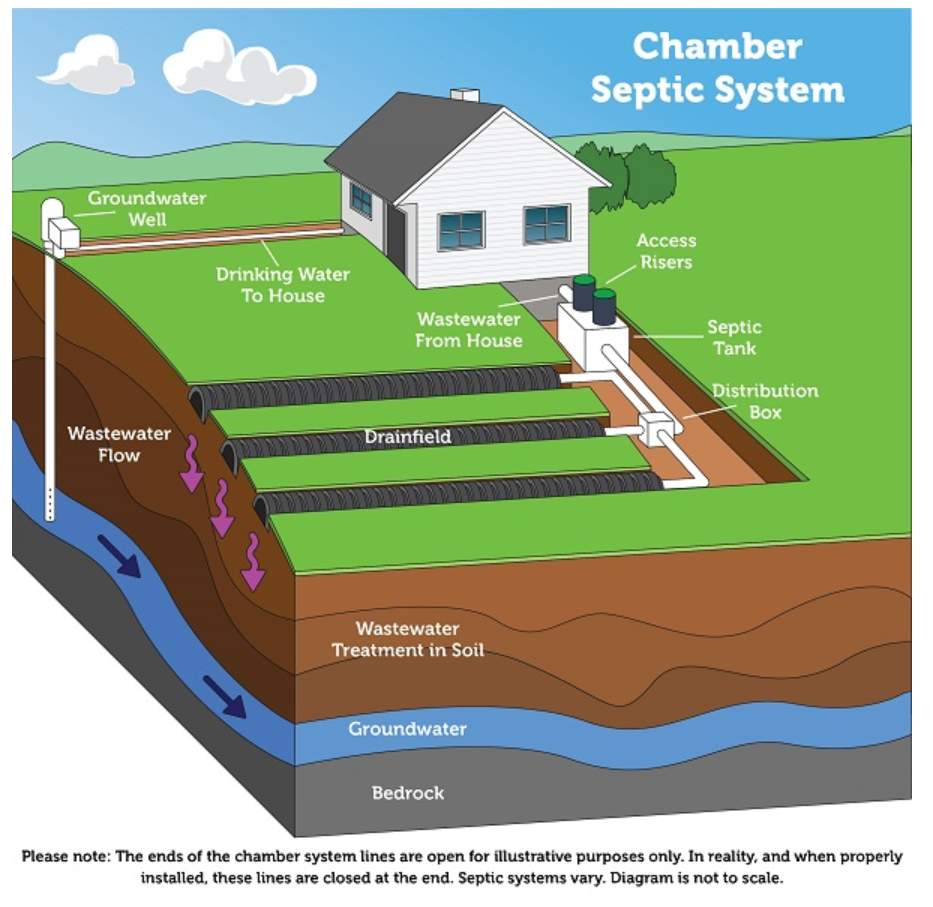
Chamber septic system. Source: US EPA
A cluster or community septic system increases the efficiency of wastewater treatment by combining the wastewater from a group of houses. Each house has its own septic tank providing initial treatment. The effluent comes together and flows through a shared drainfield. These systems work best in rural, growing communities with houses near each other.
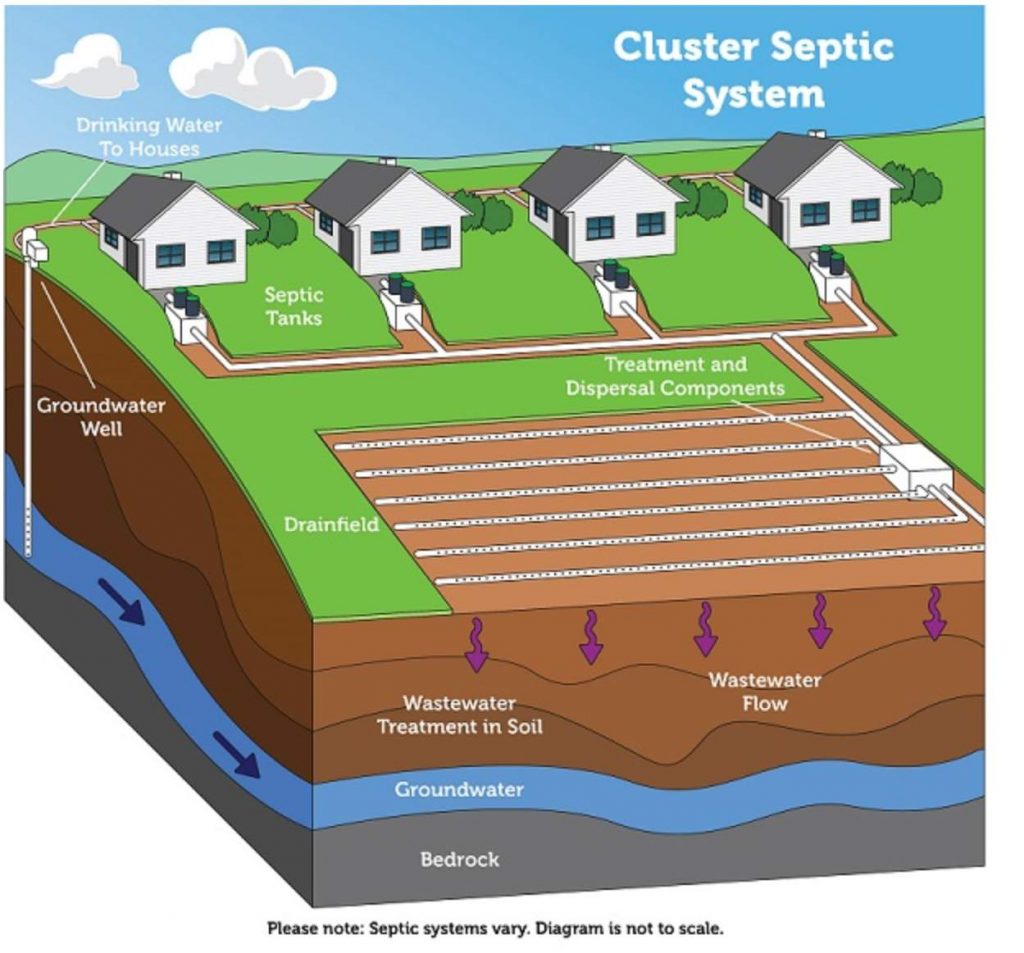
Cluster septic system. Source: US EPA
New septic system technologies including sand filters are increasing the capacity for nutrient removal from effluent prior to discharge. Sand filters, as shown in the diagram below, are more expensive than conventional systems but can help mitigate nutrient levels in nearby water bodies.
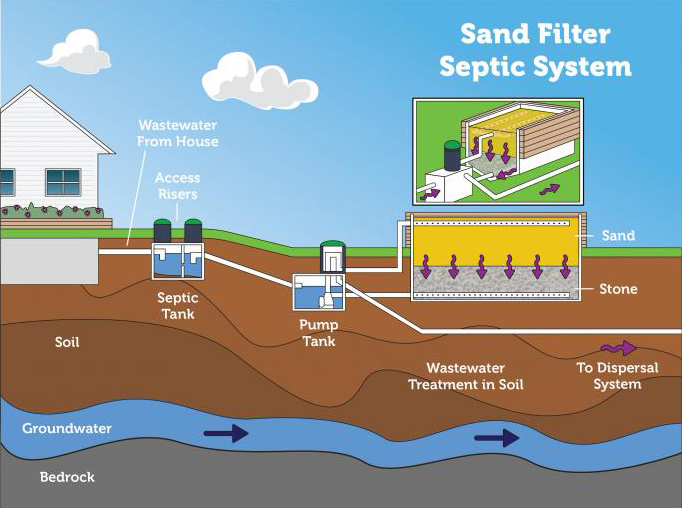
Sand filter septic system. Source: US EPA
In places with aquatic ecosystems that are particularly sensitive to nutrient pollution, aerobic treatment units offer a small-scale version of the treatments used at centralized treatment plants. Adding oxygen increases bacterial activity to reduce nutrient levels. Some systems have additional treatment tanks with a disinfection step to remove pathogens.
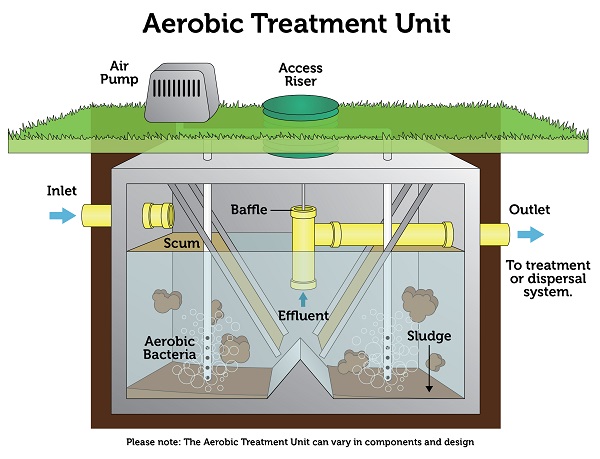
Aerobic treatment unit. Source: US EPA
See the case study from Long Island, New York describing efforts to replace old septic systems with nitrogen reducing systems with shallow leach fields that can prevent approximately 95% of nitrogen from wastewater effluent from entering the watershed and allow groundwater aquifers to recharge.
Systems for Resource Recovery
Resource recovery refers to the capture and reuse of water and solids from human waste. Benefits of resource recovery strategies include removing nutrients and contaminants that are hazardous to human and ocean health and recovering valuable resources from waste. They can also be implemented as a sanitation system where one didn’t exist or improve/replace an outdated treatment system. Some strategies for resource recovery include:
- Freshwater reclamation for irrigation and other non-potable uses, which can also reduce water needed for future sanitation and treatment.
- Biosolids added to soil as fertilizer when treated to appropriate standards (for example, Loop Biosolids Seattle, USA which uses microbes and heat for digestion to create a product to use in gardens and forests).
- Microfiltration, reverse osmosis, and UV to create potable drinking water (for example used by Orange County Water District’s groundwater replenishment system for drinking water in Los Angeles, USA).
- Biogas generation through anaerobic digestion and methane capture—often employed by large scale wastewater treatment plants to recover resources, treat biosolids, and mitigate greenhouse gas emissions.
Resource recovery is gaining traction as a solution for both small, decentralized systems and large, centralized treatment plants.
Three projects or operations are presented in more detail below, offering examples of small, container-based solutions and large, municipal scale innovation.
In Haiti, the non-governmental organization SOIL (Sustainable Organic Integrated Livelihoods) is applying resource recovery technology to provide container-based sanitation and agricultural fertilizer. This system safely provides container-based toilets to those without access and offers a solution to pollution and erosion. SOIL collects the containers weekly to divert urine and isolate solid waste from waterways and prevent illnesses. SOIL then transports waste to a composting facility where it is treated to standards defined by the World Health Organization. The finished fertilizer is sold to farmers to increase their crop yields and reduce erosion.
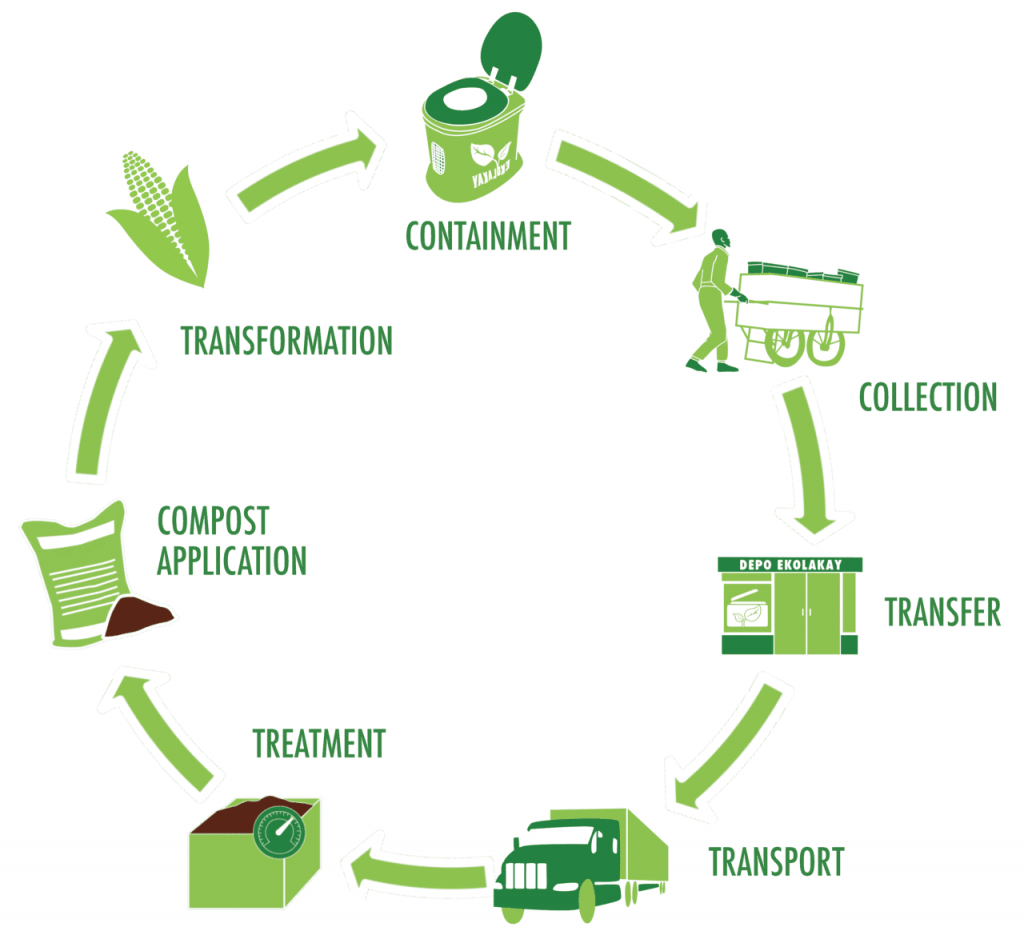
Illustration of the SOIL container-based sanitation and resource recovery process. Source: SOIL
Infrastructure is often constrained by the topography of the region. Floating areas, floodplains, impermeable soils, and coastal zones can make it difficult to implement many systems. The HandyPod is a low cost system that consists of three connected containers that gradually treats wastewater and discharges it either into an aquatic or land environment. See the case study from Tonle Sap Lake, Cambodia and Lake Indawgyi, Myanmar describing the development and implementation of Handypods by Wetlands Work.
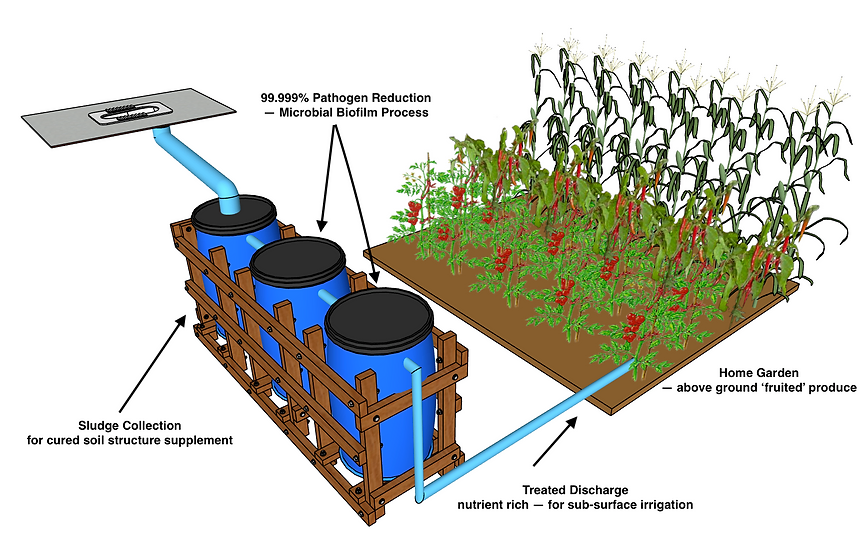
The HandyPod system. Source: Wetlands Work
Ideally, resource recovery creates value from waste through an entirely closed loop system, as exemplified by Sedron Technologies’ Janicki Omni Processor. The Omni Processor takes in human waste and garbage and turns it into electric power and clean drinking water. It works like a steam power plant, an incinerator, and a water filtration system combined into one. Though still a prototype in Dakar, Senegal, the system demonstrates the potential to offset costs associated with operations (since it produces its own energy to run) and natural resource inputs (since sewage and trash are free). In its first year in Dakar, the Omni Processor processed an estimated 700 tons of fecal sludge. Recognizing the high initial costs to build this system, the Omni Processor is a prospective replacement for large scale wastewater treatment plants serving cities around the world in the future.
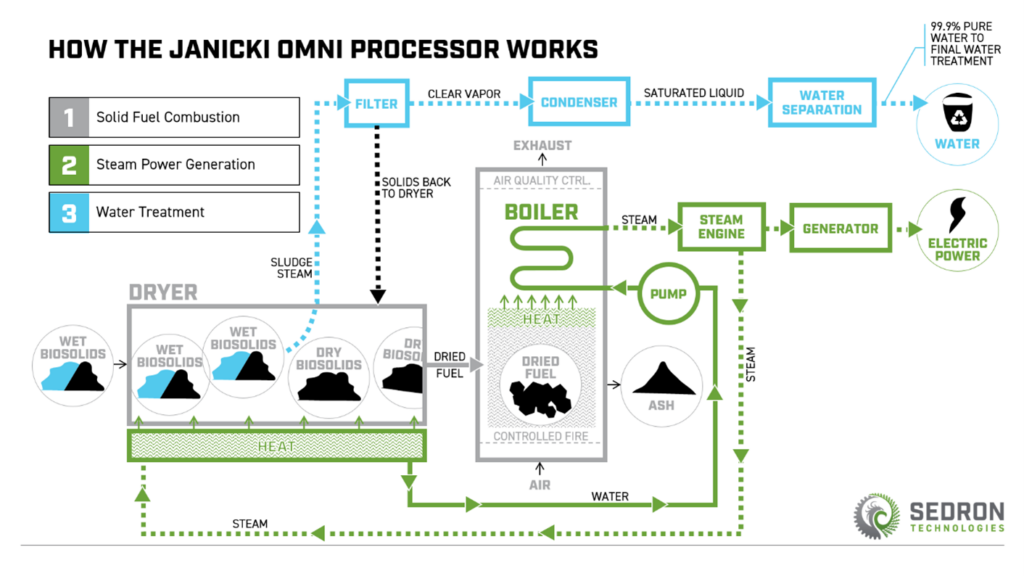
Janicki Omni Processor. Source: Janicki Bioenergy
Recent Innovations
- Geotextile sand filters work by moving water first through a geotextile fabric and plastic material and then through sand for additional filtration. This system provides an alternative to onsite septic systems.
- Bioreacter gardens use natural processes (denitrying bioreactors) in soil and vegetation to clean water coming from septic systems. The gardens reduce the primary components of wastewater: ammonia, nitrate, phosphorous, and bacteria through three layers of plants. The top layer breaks down pollutants and natural organisms, the middle layer converts ammonia into nitrate, and a third layer contains wood chips and biochar to convert nitrate into harmless nitrogen gas. Bioreactor gardens have been used effectively in Hawai‘i and Palau, see Ridge to Reefs for more information on these projects.
- Glass filters use crushed glass, including recycled glass from beer and wine bottles, as a molecular sieve to treat wastewater. The glass filtration system can be used in multiple applications, including to filter drinking water and treat industrial water. This technology has been gaining ground in Europe, including in the Dryden Aqua plant in Scotland.
- Vermiculture relies on the use of worms to remove contaminants from wastewater. The resulting water can be reused for agriculture and a valuable soil is also produced. The system consists of a layer with wood shavings, earthworms, and microbes, a second layer of crushed rock, and a third layer which serves as a drainage basin. For more information on this system read this case study on vermiculture in Hawai‘i.
Nature-based Solutions
Nature-based Solutions are actions to protect, sustainably manage, and restore natural and modified ecosystems that address societal challenges. In a wastewater context, Nature-based Solutions refer to the planned and deliberate use of ecosystems and ecosystem services to improve water quality or quantity, and to increase resilience to climate change. ref For wastewater pollution, Nature-based Solutions use strategies such as plants and microbes to break down, absorb, trap, and/or oxygenate pollutants in contaminated water as it moves through the environment. These natural processes effectively capture and filter contaminated surface and groundwater, including polluted runoff from rainfall, before it is discharged into the ocean.
Nature-based Solutions also include constructed wetlands, bioswales, activated charcoal deposits, settlement ponds, riparian buffer zones, and more. These strategies can enhance pathogen removal by providing extended interaction with oxygen and microbes by slowing down flow rates and coupling the Nature-based Solutions with additional treatment steps from a centralized or decentralized system. They also have the added benefit of providing habitat to support biodiversity, supporting recreation (including fishing and tourism), and aesthetic benefits over other treatment technologies.
Explore these three examples for a closer look at Nature-based Solutions:
- In Guánica Bay, Puerto Rico, green infrastructure, including a vetiver grass rain garden, was used to provide additional treatment to septic tank discharge, enhancing contaminant removal and significantly reducing the volume of wastewater entering the bay.
- In American Samoa, biochar (charcoal produced from organic matter) and vetiver grass were used for erosion control and to remove nutrients.
- In the Dominican Republic, a constructed wetland (a shallow water body or gravel or engineered media filled basins vegetated with plants that are adapted for water flow) was used to help address the significant need to capture and treat wastewater.
Establishing and Implementing Wastewater Regulations
Laws, regulations, and codes can be highly effective solutions to mitigate wastewater pollution, but can be challenging to create, amend, or influence. Examples of regulation-related wastewater strategies include: ref
- Setting wastewater discharge standards, which is one of the most common approaches to regulating and reducing wastewater pollution but can be complex and generating the data required is a massive undertaking.
- Determining treatment level targets, where a target reduction of pollution is set for each treatment stage (primary, secondary, tertiary).
- Setting a pollutant load reduction target, where a policy is created calling out a specific goal to lessen pollutants over time (e.g., reduce at least 50% of excess nutrients and other chemicals).
Regulations and policies to manage wastewater will vary based on local, regional, and national efforts as well as the social, environmental, and political context. Explore pages 22-28 of A Practitioner's Guide to Ocean Wastewater Pollution to learn more about existing frameworks at the regional and country-level, such as the Sustainable Development Goals (SDGs), as well as different actions to consider when trying to create, amend, or influence wastewater laws, regulations, or codes. Examples include: considering land-based pollution and water quality laws and regulations, writing national legislation to improve water quality, and developing ballot initiatives to fund wastewater and waste management infrastructure. Also, see the Collaboration section of this toolkit for more information on coordinating across sectors and an integrated approach to wastewater pollution.
